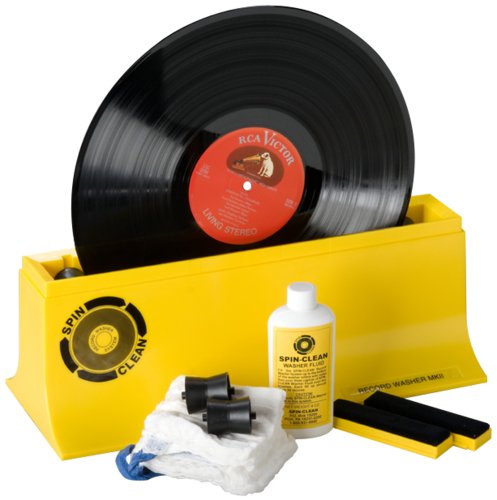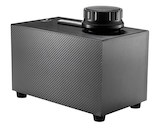Spin-Clean Record Washer review

We’ll be the first to acknowledge that compact discs seldom (if ever) need cleaning. Unless there’s a major boo-boo, merely keeping them in their “jewel cases” when not in use should guarantee that much-vaunted (but often questionable) “perfect sound forever.”
And, of course, we’ll readily admit that digitally downloaded files can’t get dirty. They are, after all, utterly amorphous.

Below, for the sake of comparison, take a look at the interactive table and see how well the Spin-Clean compares to other popular record cleaners:
| Photo | Model |
|---|---|
 | Pro-Ject VC-E |
 | Record Doctor VI |
 | Pro-Ject VC-S2 ALU |
 | HumminGuru |
 | VPI HW-16.5 |
 | Record Doctor VI |
Vinyl LP records, on the other hand, present a static charge that naturally attracts dust, which can lead to those pesky pops and clicks and, ultimately, to damage. Oily fingerprints also muddy things up. Records that are deeply pitted or scratched are pretty much beyond hope. But records can be cleaned, and the best way to do it is a topic (like so many others) of endless and often rancorous debate among audiophiles. One thing is certain: All cleaning methods work to one degree or another.
Some folks literally toss records in the dishwasher; others use gentle, carbon fiber brushes before each play. Some spray LPs with small bursts of compressed air. Others merely wipe with a microfiber cloth. Still others swear by wood glue.
Yes, wood glue.
The simplest solutions are effective for minor cleaning, but seriously grungy records are another story. Fortunately, there is a host of terrific vinyl record cleaners on the market to make the process easy and thorough, with prices all over the map.
One of the most popular is the Spin-Clean Record Washer (about $75 for the basic package; other options come with additional supplies). It’s a simple, mechanical (non-electric) method that has been around in one permutation or another courtesy of this U.S. company for more than 40 years.
Does it do the job? How do you use it? Stick around for a while and we’ll take a look at the Spin-Clean and compare it with other available solutions.
How the Spin-Clean Works
The Spin-Clean comes boxed with everything that’s required. It consists of a brightly colored (there’s a clear version as well) plastic box. To get it up and cleaning:
Remove the lid (it should be kept attached for storage).
Insert two rollers in slots appropriate for the size of the record being cleaned.
Pop two brushes into two center slots. (The brushes are said to last for thousands of cleanings.)
Add distilled water to a measuring line marked on the interior plastic
Pour three capfuls (of a 4-ounce bottle) of washer fluid onto the brushes. (That bottle will clean an estimated 700 records.)
Place the record between the brushes and rotate three times clockwise and three times counterclockwise.
Remove the record and use the supplied, reusable clothes to dry the vinyl. Don’t play a record wet! It doesn’t hurt to lay records flat on towels or even in a dish drainer to make sure they’re completely dry.
Remove the brushes, rinse them, and let them thoroughly air dry on top of the closed unit.
The process is indeed simple, and that fluid application and “cleaning bath” is good for up to 50 cleanings. Whatever gunk has been removed can be seen in the bottom of the unit. Depending on how dirty your records were, you might want to start fresh more often. Spin-Clean sensibly recommends cleaning records in batches to get the most out of a treatment of fluid.
Our impression of the Spin-Clean was a very positive one. With vinyl that we had stored properly, wiped or brushed before playing, and returned to its sleeve promptly after playing, we noticed very little residue at the bottom of the unit and no appreciable difference in playback. But, with some thrift-store “gems,” it was another story.
Let’s face it: Some of those fifty-cent wonders might look OK, but a visual inspection doesn’t tell the whole story. They might have deeply imbedded crud. They can even smell bad.
We had always considered one old LP (Rubenstein doing up the lovely Grieg piano concerto, RCA) pretty much unplayable due to lots of pops and a smear of some type of white substance we just couldn’t rub away by hand. After a Spin-Clean treatment, the smear was gone, as was a good 50 percent of the surface noise. A second pass through the Spin-Clean cut the noise even further.
Did the bargain record ultimately play like new? No, and it’s unreasonable to expect that it would. But it was rendered listenable, and that’s truly saying something. On the other hand, records long in our collection didn’t demonstrate much difference, as they weren’t very “dirty” to begin with.
Professional critics and users alike have almost universally praised the Spin-Clean, and for good reason. It’s inexpensive when compared with other products, easy (and surprisingly tidy) to use, and it produces results on problem LPs. It delivers what it promises, and it is absolutely worth a try.
| Best Selling Turntables |
|---|
| 1) Audio-Technica AT-LP120XUSB |
| 2) Sony PS-LX310BT |
| 3) Audio-Technica AT-LP3 |
The Competition
As is so common in life, more money buys more stuff. When it comes to record cleaning, merely having the machine automatically rotate the record considerably boosts the price tag. Beyond that, the sky’s the limit – for example, you can spend a cool $3,000 on something called the AUDIO Desk Systeme Vinyl Cleaner Ultimate Ultrasonic LP Cleaning Machine, assuming that your hedge funds are doing quite well.
There are, however, much more sensible alternatives:

The Record Doctor V ($199) is comparable in many ways to the Spin-Clean, but adds a fairly attractive wood cabinet and vacuuming function. The record still must be rotated manually, although the supplied one-finger “record turner” clamp is quite handy. (The Spin-Clean requires that the user actually touch the edge of the vinyl.)
Vacuuming helps to remove potential fluid residue and dry the record. The extra expenditure can be worth it if you buy a lot of thrift-store records and want a cleaner that looks more like a piece of furniture. Its basic use is quite simple, but users will naturally develop their own techniques when it comes to how much fluid to use and how many times to turn the LP. With any of these devices, it may well be necessary to clean a particularly awful piece of vinyl more than one time.

The Okki Nokki RCM Record Cleaning Machine ($499) looks like a heavy-duty piece of industrial hardware, and it behaves like one. Designed in the Netherland by avid collector and overall record connoisseur Johan Bezem, it also resembles (appropriately enough) a turntable.
In this case, the platter automatically turns the record in both directions while you use a goats-hair brush and a proprietary fluid (mixed with distilled water) to scrub it clean. A vacuum pump then sucks the excess fluid into a reservoir, from which it later can be evacuated by a retractable tube.
The Okki Nokki is generally considered the best machine in its price class and might be a last resort for making truly filthy records listenable. Innumerable YouTube videos show impressive results.
-
Knosti
The Knosti Disco Antistat Record Washing System out of Germany ($60) is very much in the league of the Spin-Clean-– a budget-friendly, all-manual, fluid and brush-based cleaning solution. Its operation is very much the same, and users rate it on a par with the Spin-Clean as far as results go.
But it has a couple of added selling points that are worth noting. The Knosti’s clamp protects record labels from potential fluid damage as well as it makes it easier to turn the records.
And there’s yet one more thoughtful little bonus feature – it comes with its own drying rack. One minor drawback – it’s a bit harder to find than the Spin-Clean.
Coming Clean
A quick personal note: When I was a teenager, certain members of my immediate family – who shall remain nameless – made me the butt of jokes because of the way I would carefully handle a record before playing it. And they’d actually guffaw when I’d pull out the soft little cloth and give it a light wipe.
“Like a doctor preparing for surgery,” they’d laugh.
All I can tell you is this: That simple, routine care has meant that albums that I purchased in 1962 are still in excellent physical shape and sound sweet to this day. That’s because if you properly play records (with correct stylus pressure, balanced tonearm, etc.), they really don’t get “dirty,” and they just don’t wear out.
Now that’s “perfect sound forever.”
- If you enjoyed this article, please take a moment to “like” our brand new Facebook page!




